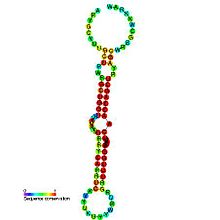- mir-133 microRNA precursor family
-
mir-133 microRNA precursor family 
Predicted secondary structure and sequence conservation of mir-133 Identifiers Symbol mir-133 Rfam RF00446 miRBase MI0000450 miRBase family MIPF0000029 Other data RNA type Gene; miRNA Domain(s) Eukaryota GO 0035195 0035068 SO 0001244 mir-133 is a type of non-coding RNA called a microRNA that was first experimentally characterised in mice[1] and homologues have since been discovered in several other species including invertebrates such as the fruitfly Drosophila melanogaster. Each species often encodes multiple microRNAs with identical or similar mature sequence. For example, in the human genome there are three known miR-133 genes: miR-133a-1, miR-133a-2 and miR-133b found on chromosomes 18, 20 and 6 respectively. The mature sequence is excised from the 3' arm of the hairpin. miR-133 is expressed in muscle tissue and appears to repress the expression of non-muscle genes.[2]
Contents
Regulation
It is proposed that Insulin activates the translocation of SREBP-1c (BHLH) active form from the endoplasmic reticulum (ER) to the nucleus and, concomittantly, induces SREPB-1c expression via PI3K signaling pathway. SREBP-1c mediates MEF2C downregulation through a mechanism that remains to be determined. As a consequence of lower MEF2C binding on their enhancer region, the transcription of miR-1 and miR-133a is reduced, leading to decreased levels of their mature forms in muscle, after insulin treatment. Altered activation of PI3K and SREBP-1c may explain the defective regulation of miR-1 and miR-133a expression in response to insulin in muscle of type 2 diabetic patients. [3]
Targets of miR-133
microRNAs act by lowering the expression of genes by binding to target sites in the 3' UTR of the mRNAs. Luo et al.. demonstrated that the HCN2 K+ channel gene contains a target of miR-133.[4] Yin et al.. showed that the Mps1 kinase gene in zebrafish is a target.[5] Luo et al.. demonstrated that the voltage gated K+ channel KCNQ1 is a target.[6] Boutz et al.. showed that nPTB (neuronal polypyrimidine tract-binding protein) is a target and likely contains two target sites for miR-133.[7] Xiao et al.. show that ether-a-go-go related gene (ERG) a K+ channel is a target of miR-133.[8]
miR-133 directly and negatively regulates NFATc4.[9][10]
RhoA expression is negatively regulated by miR-133a in bronchial smooth muscles (BSM)and miR-133a downregulation causes an upregulation of RhoA, resulting in an augmentation of contraction and BSM hyperresponsiveness. [11]
BMP2 downregulates multiple mIRs, of which one, miR-133, directly inhibits Runx2, an early BMP response gene essential for bone formation. Although miR-133 is known to promote MEF-2-dependent myogenesis, it also inhibits Runx2-mediated osteogenesis. BMP2 controls bone cell determination by inducing miRNAs that target muscle genes but mainly by down-regulating multiple miRNAs that constitute an osteogenic program, thereby releasing from inhibition pathway components required for cell lineage commitment establish a mechanism for BMP morphogens to selectively induce a tissue-specific phenotype and suppress alternative lineages. [12]
Nicotine activates α7-nAChR and downregulates the levels of miR-133 and miR-590 leading to significant upregulation of expression of TGF-β1 and TGF-βRII at the protein level establishing miR-133 and miR-590 as repressors of TGF-β1 and TGF-βRII. [13]
miR-133 enhances myoblast proliferation by repressing serum response factor (SRF)[14]
mIR-133 supressses SP1 expression[15]
References
- ^ Lagos-Quintana, M; Rauhut R, Yalcin A, Meyer J, Lendeckel W, Tuschl T (2002). "Identification of tissue-specific microRNAs from mouse". Curr Biol 12 (9): 735–739. doi:10.1016/S0960-9822(02)00809-6. PMID 12007417.
- ^ Ivey KN, Muth A, Arnold J, et al (March 2008). "MicroRNA Regulation of Cell Lineages in Mouse and Human Embryonic Stem Cells". Cell Stem Cell 2 (3): 219–29. doi:10.1016/j.stem.2008.01.016. PMC 2293325. PMID 18371447. http://www.pubmedcentral.nih.gov/articlerender.fcgi?tool=pmcentrez&artid=2293325.
- ^ PMID: 19720801
- ^ Luo X, Lin H, Pan Z, et al (May 2008). "Downregulation of MIRNA-1/MIRNA-133 contributes to re-expression of pacemaker channel genes HCN2 and HCN4 in hypertrophic heart". J. Biol. Chem. 283 (29): 20045–52. doi:10.1074/jbc.M801035200. PMID 18458081.
- ^ Yin VP, Thomson JM, Thummel R, Hyde DR, Hammond SM, Poss KD (March 2008). "Fgf-dependent depletion of microRNA-133 promotes appendage regeneration in zebrafish". Genes Dev. 22 (6): 728–33. doi:10.1101/gad.1641808. PMC 2275425. PMID 18347091. http://www.pubmedcentral.nih.gov/articlerender.fcgi?tool=pmcentrez&artid=2275425.
- ^ Luo X, Xiao J, Lin H, et al (August 2007). "Transcriptional activation by stimulating protein 1 and post-transcriptional repression by muscle-specific microRNAs of IKs-encoding genes and potential implications in regional heterogeneity of their expressions". J. Cell. Physiol. 212 (2): 358–67. doi:10.1002/jcp.21030. PMID 17443681.
- ^ Boutz PL, Chawla G, Stoilov P, Black DL (January 2007). "MicroRNAs regulate the expression of the alternative splicing factor nPTB during muscle development". Genes Dev. 21 (1): 71–84. doi:10.1101/gad.1500707. PMC 1759902. PMID 17210790. http://www.pubmedcentral.nih.gov/articlerender.fcgi?tool=pmcentrez&artid=1759902.
- ^ Xiao J, Luo X, Lin H, et al (April 2007). "MicroRNA miR-133 represses HERG K+ channel expression contributing to QT prolongation in diabetic hearts". J. Biol. Chem. 282 (17): 12363–7. doi:10.1074/jbc.C700015200. PMID 17344217.
- ^ Li, Q.; Lin, X.; Yang, X.; Chang, J. (2010). "NFATc4 is negatively regulated in miR-133a-mediated cardiomyocyte hypertrophic repression". AJP: Heart and Circulatory Physiology 298 (5): H1340–H1347. doi:10.1152/ajpheart.00592.2009. PMID 20173049.
- ^ PMID 20177001 (PubMed)
Citation will be completed automatically in a few minutes. Jump the queue or expand by hand - ^ PMID 20953121 (PubMed)
Citation will be completed automatically in a few minutes. Jump the queue or expand by hand - ^ PMID 18784367
- ^ Cardiovasc Res (2009) 83 (3): 465-472. doi: 10.1093/cvr/cvp130
- ^ Nature Genetics 38, 228 - 233 (2005) Published online: 25 December 2005 | doi:10.1038/ng1725
- ^ Circulation Research. 2011; 109: 880-893 Published online before print August 18, 2011, doi: 10.1161/CIRCRESAHA.111.240150
External links
- Rfam page for mir-133 microRNA precursor family
- miRBase entry for mir-133
- MicroRNA of the week at the miRNA blog
miRNA precursor families 1-100 101-200 201+ Other Categories:- MicroRNA
- Molecular and cellular biology stubs
Wikimedia Foundation. 2010.
